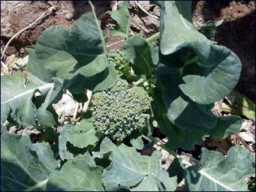From Gardening
Solutions
Institute of Food and Agricultural Sciences, University of Florida
Broccoli
Broccoli is a popular
and easy-to-grow winter crop here in Florida. Plus, it’s incredibly
nutritious, providing good amounts of riboflavin, calcium, iron, and
vitamins A and C.
Characteristics
You
may be aware that broccoli is a member of the cruciferous family of
vegetables along with kale, cabbage, cauliflower, kohlrabi, and
Brussels sprouts. What you may not know is that these vegetables are
all actually members of the same
species—you read that right, species. Brassica oleracea
includes broccoli as well as those vegetables previously mentioned.
Thousands of years of human cultivation and selective breeding has
resulted in changes to the wild Brassica
oleracea
that have given us the vegetables we know and love today. Native to the
Mediterrean, the original wild plant was grown for its foliage; the
choice plants were those that grew larger leaves. Over time, through
saving seeds and continuing to grow those plants with the largest
leaves, the vegetable we know now as kale came onto the scene by the
fifth century B.C. Botanically, kale is Brassica oleracea
var. acephala
which means "cabbage of the vegetable garden without a head." Continued
selective breeding went on to result in cabbage (Brassica oleracea var.
capita) and kohlrabi (Brassica
oleracea var. caulorapa).

It
has only been in the past thousand years that people began selecting
plants for their immature flower buds. This selection resulted in the
introduction of cauliflower (Brassica
oleracea var. botrytis)
by the fifteenth century and finally broccoli (Brassica oleracea var.
italica)
in the sixteenth century. Broccoli received the variety name italica
because it was developed in Italy. Finally, the eighteenth century
would bring about the selection of Brussels sprouts (Brassica oleracea var.
gemmifera).
It is amazing to think that selective breeding can result in such
unique vegetables of the same genus and species!
Planting and
Care
Broccoli
needs cool weather to thrive, so here in Florida it should be planted
during fall and winter. It takes 80-100 days to mature, so don't plant
too late in the season—rising temperatures may cause the plants to
"bolt," meaning the flowers within the head will start to open.
In
South Florida, broccoli transplants can be planted in the garden from
September through January. North and Central Florida gardeners can
plant transplants anytime from mid-August through mid-March. You can
buy transplants at a garden center or start your own from seed.
Like
all plants, broccoli needs certain nutrients in order to grow, so
fertilizing with a 6-8-8 fertilizer of nitrogen (N), phosphorous (P)
and potassium (K) will help your plants succeed. You can use either a
liquid fertilizer solution or a controlled-release solid fertilizer.
You should fertilize at planting time and then regularly throughout the
growing season. A layer of mulch can help retain moisture around the
plants and suppress weed growth.
Although broccoli is a
cool-season vegetable, it will still benefit from protection from low
temperatures (32°F or cooler), especially when plants are young and
tender.
Vegetables like broccoli need at least four to six hours
of sun per day, so you'll need to find a sunny spot. Vegetables also
need plenty of water, so be sure that you have a convenient source
nearby. Provide one to two inches of water per week; heavy soakings
once a week are preferred to several lighter sprinklings.
A
number of broccoli varieties are available, with 'Waltham 29' being an
old favorite. It can be harvested 80-100 days from when it is
transplanted and will continue to produce side shoots after the main
head is cut. Other good varieties for Florida include 'Early Green',
'Early Dividend', 'Green Sprouting'/'Calabrese', 'Packman', and 'De
Cicco'.
It's also a good idea to have your soil tested through
your local Extension office before you plant. Ideally, you're hoping
for a soil that falls in the pH range of 6.2 to 6.5. Consider amending
the soil with organic materials like composted manure before planting
your broccoli.
|
|
